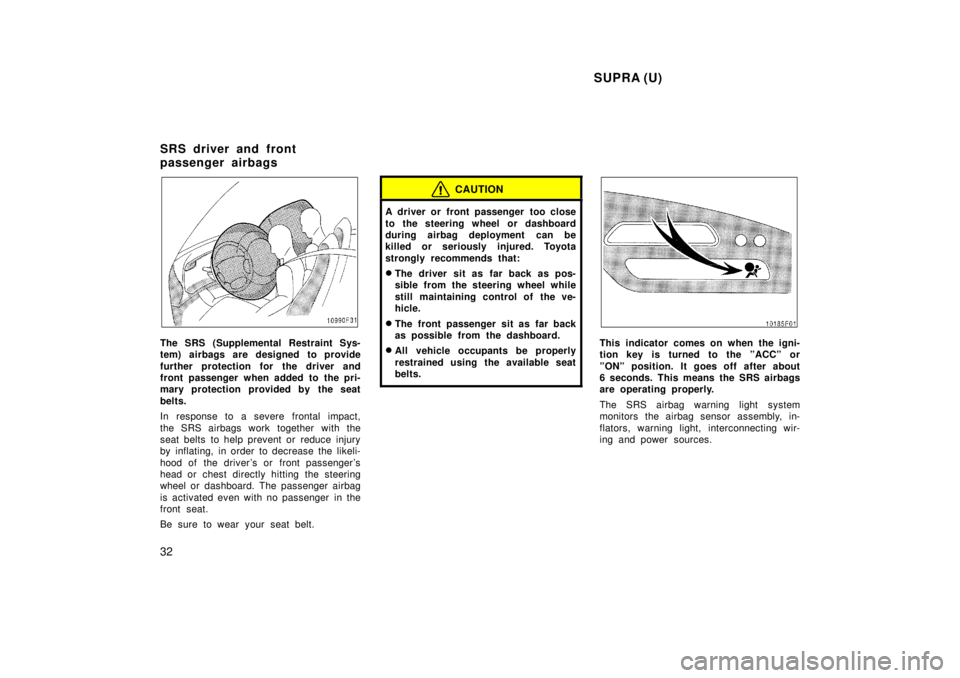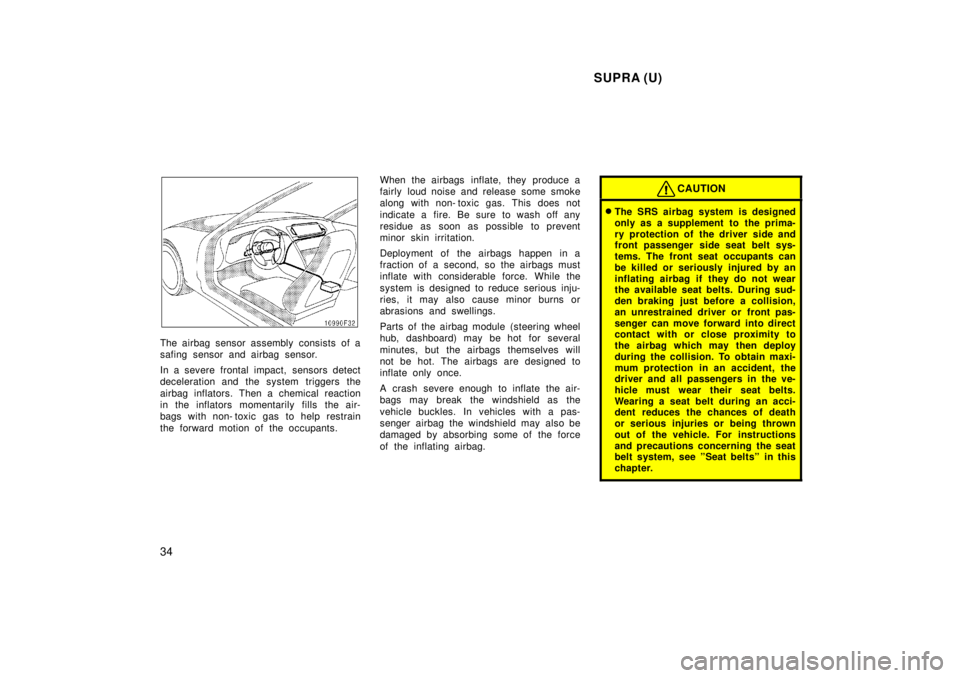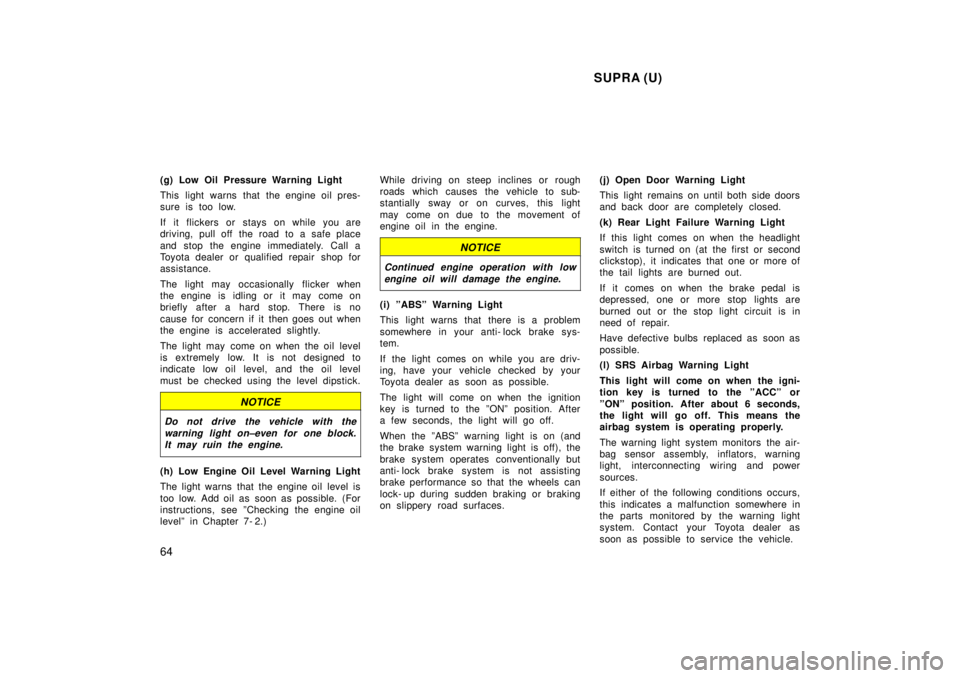1998 TOYOTA SUPRA airbag off
[x] Cancel search: airbag offPage 5 of 191

SUPRA (U)5
Indicator symbols on the instrument panel
Slip indicator light
SRS airbag warning light
*
1
Traction control system off indicator/warning light *
1
Seat belt reminder light
*
1
Open door warning light *
1
Low oil pressure warnig light *
1
Master warning light
*
1
Brake system warning light *
1
Discharge warning light *
1
Malfunction indicator lamp *
1
Snow mode indicator light
Anti-lock brake system warning light *
1
Rear light failure warning light *
1
Low engine oil level warning light *
1
Page 32 of 191

SUPRA (U)
32
The SRS (Supplemental Restraint Sys-
tem) airbags are designed to provide
further protection for the driver and
front passenger when added to the pri-
mary protection provided by the seat
belts.
In response to a severe frontal impact,
the SRS airbags work together with the
seat belts to help prevent or reduce injury
by inflating, in order to decrease the likeli-
hood of the driver 's or front passenger 's
head or chest directly hitting the steering
wheel or dashboard. The passenger airbag
is activated even with no passenger in the
front seat.
Be sure to wear your seat belt.
CAUTION
A driver or front passenger too close
to the steering wheel or dashboard
during airbag deployment can be
killed or seriously injured. Toyota
strongly recommends that: � The driver sit as far back as pos-
sible from the steering wheel while
still maintaining control of the ve-
hicle.
� The front passenger sit as far back
as possible from the dashboard.
� All vehicle occupants be properly
restrained using the available seat
belts.
This indicator comes on when the igni-
tion key is turned to the ºACCº or
ºONº position. It goes off after about
6 seconds. This means the SRS airbags
are operating properly.
The SRS airbag warning light system
monitors the airbag sensor assembly, in-
flators, warning light, interconnecting wir-
ing and power sources.
SRS driver and front
passenger airbags
Page 34 of 191

SUPRA (U)
34
The airbag sensor assembly consists of a
safing sensor and airbag sensor.
In a severe frontal impact, sensors detect
deceleration and the system triggers the
airbag inflators. Then a chemical reaction
in the inflators momentarily fills the air-
bags with non- toxic gas to help restrain
the forward motion of the occupants. When the airbags inflate, they produce a
fairly loud noise and release some smoke
along with non- toxic gas. This does not
indicate a fire. Be sure to wash off any
residue as soon as possible to prevent
minor skin irritation.
Deployment of the airbags happen in a
fraction of a second, so the airbags must
inflate with considerable force. While the
system is desi
gned to reduce serious inju-
ries, it may also cause minor burns or
abrasions and swellings.
Parts of the airbag module (steering wheel
hub, dashboard) may be hot for several
minutes, but the airbags themselves will
not be hot. The airbags are designed to
inflate only once.
A crash severe enough to inflate the air-
bags may break the windshield as the
vehicle buckles. In vehicles with a pas-
senger airbag the windshield may also be
damaged by absorbing some of the force
of the inflating airbag.
CAUTION
� The SRS airbag system is designed
only as a supplement to the prima-
ry protection of the driver side and
front passenger side seat belt sys-
tems. The front seat occupants can
be killed or seriously injured by an
inflating airbag if they do not wear
the available seat belts. During sud-
den braking just before a collision,
an unrestrained driver or front pas-
senger can move forward into direct
contact with or close proximity to
the airbag which may then deploy
during the collision. To obtain maxi-
mum protection in an accident, the
driver and all passengers in the ve-
hicle must wear their seat belts.
Wearing a seat belt during an acci-
dent reduces the chances of death
or serious injuries or being thrown
out of the vehicle. For instructions
and precautions concerning the seat
belt system, see ºSeat beltsº in this
chapter.
Page 62 of 191

SUPRA (U)
62 (i) Take vehicle to
Toyota dealer.
If the indicator or Do this.
buzzer comes on...
(j) Close both side door and back door.
(k) Replace bulb.
(g) Stop and check.
(h) Add engine oil.
(f) Fill up tank.
Low fuel level
warning lightIf the indicator or Do this.
buzzer comes on...
(n) Remove key. Key reminder
buzzer
(l) Take vehicle to
Toyota dealer
immediately.
(m) Take vehicle to Toyota dealer.
(a) Master Warning Light
This light warns that another service re-
minder indicator (except seat belt reminder
light, low fuel level warning light, rear light
failure warning light, SRS airbag warning
light and ºTRAC OFFº indicator/warning
light) is on.
If it comes on while you are driving,
check the other service reminder indicator
that is on with reference to the following
description of the indicator.
(b) Brake System Warning Light
This light has the following functions:
Parking brake reminder
If this light is on, make sure the parking
brake is fully released. The light should
go off.
Low brake fluid level warning
If this light comes on and stays on while
you are driving, slow down and pull off
the road. Then stop the vehicle carefully.
Remember that stopping distance and ped-
al effort may be increased. There may be
a problem somewhere in the brake sys-
tem. Check the fluid level of the see-
through reservoir.
Page 64 of 191

SUPRA (U)
64
(g) Low Oil Pressure Warning Light
This light warns that the engine oil pres-
sure is too low.
If it flickers or stays on while you are
driving, pull off the road to a safe place
and stop the engine immediately. Call a
Toyota dealer or qualified repair shop for
assistance.
The light may occasionally flicker when
the engine is idling or it may come on
briefly after a hard stop. There is no
cause for concern if it then goes out when
the engine is accelerated slightly.
The light may come on when the oil level
is extremely low. It is not designed to
indicate low oil level, and the oil level
must be checked using the level dipstick.
NOTICE
Do not drive the vehicle with the
warning light on±even for one block.It may ruin the engine.
(h) Low Engine Oil Level Warning Light
The light warns that the engine oil level is
too low. Add oil as soon as possible. (For
instructions, see ºChecking the engine oil
levelº in Chapter 7- 2.) While driving on steep inclines or rough
roads which causes the vehicle to sub-
stantially sway or on curves, this light
may come on due to the movement of
engine oil in the engine.
NOTICE
Continued engine operation with low
engine oil will damage the engine.
(i) ºABSº Warning Light
This light warns that there is a problem
somewhere in your anti- lock brake sys-
tem.
If the light comes on while you are driv-
ing, have your vehicle checked by your
Toyota dealer as soon as possible.
The light will come on when the ignition
key is turned to the ºONº position. After
a few seconds, the light will go off.
When the ºABSº warning light is on (and
the brake system warning light is off), the
brake system operates conventionally but
anti- lock brake system is not assisting
brake performance so that the wheels can
lock- up during sudden braking or braking
on slippery road surfaces. (j) Open Door Warning Light
This light remains on until both side doors
and back door are completely closed.
(k) Rear Light Failure Warning Light
If this light comes on when the headlight
switch is turned on (at the first or second
clickstop), it indicates that one or more of
the tail lights are burned out.
If it comes on when the brake pedal is
depressed, one or more stop lights are
burned out or the stop light circuit is in
need of repair.
Have defective bulbs replaced as soon as
possible.
(l) SRS Airbag Warning Light
This light will come on when the igni-
tion key is turned to the ºACCº or
ºONº position. After about 6 seconds,
the light will go off. This means the
airbag system is operating properly.
The warning light system monitors the air-
bag sensor assembly, inflators, warning
light, interconnecting wiring and power
sources.
If either of the following conditions occurs,
this indicates a malfunction somewhere in
the parts monitored by the warning light
system. Contact your Toyota dealer as
soon as possible to service the vehicle.
Page 65 of 191

SUPRA (U)65
�
The light does not come on when the
ignition key is turned to the ºACCº or
ºONº position or remains on.
� The light comes on while driving.
(m) ºTRAC OFFº Indicator/Warning
Light
This light comes on when the ignition key
is turned to ºONº, and will go off after 3
seconds. This means that the system is
operating properly.
If one of the following conditions occurs,
this indicates a malfunction somewhere in
the parts monitored by the warning light
system. Contact your Toyota dealer as
soon as possible to service the vehicle.
� The light remains on more than 3 se-
conds after the ignition switch is turnedon.
� The light comes on while driving even
if the ºTRAC OFFº switch is not
pushed.
� The light flashes.
(n) Key Reminder Buzzer
This buzzer reminds you to remove the
key when you open the driver 's door with
the ignition key in the ºACCº or ºLOCKº
position. CHECKING SERVICE REMINDER INDICA-
TORS (except the low fuel level warning
light)
1. Apply the parking brake.
2. Open one of the side doors or the back door.
The open door warning light should
come on.
3. Close the side door. The open door warning light should go
off.
4. Turn the ignition key to ºACCº. The SRS airbag warning light should
come on. It goes off after about 6 se-
conds.
5. Turn the ignition key to ºONº, but do not start the engine.
All the service reminder indicators except
the open door warning light and SRS air-
bag warning light should come on. The
ºABSº warning light goes off after about 3
seconds.
If any service reminder indicator or warn-
ing buzzer does not function as described
above, either the bulb is burned out or the
circuit is in need of repair. Have it
checked by your Toyota dealer as soon as
possible.